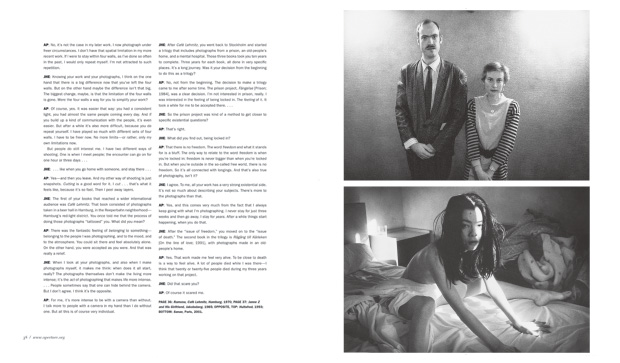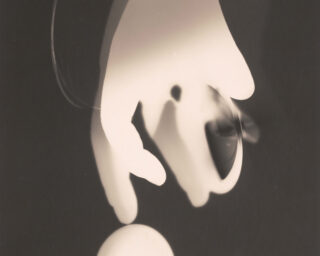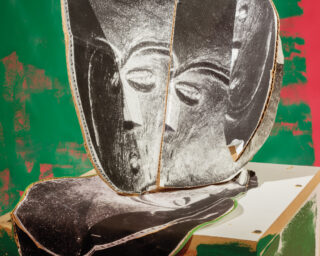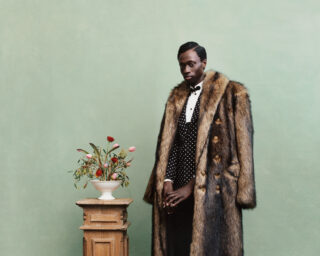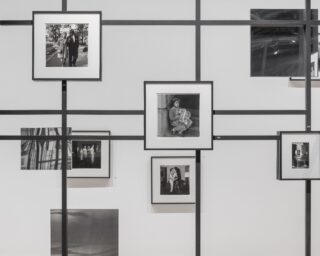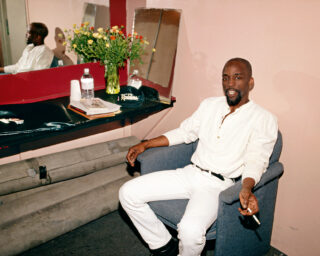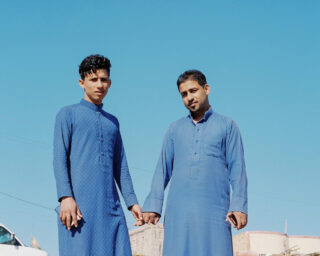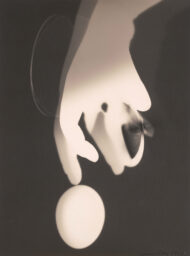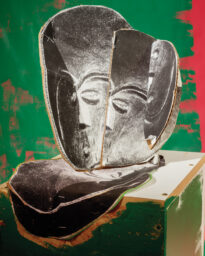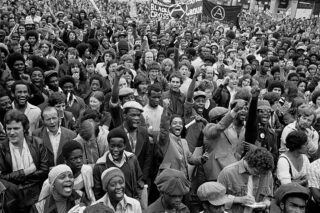Anders Petersen – Finding a Fever
One of Sweden’s most influential photographers, Anders Petersen has been producing bold and intimate black-and-white photographs since the late 1960s. His seminal book Café Lehmitz was published in 1978 and remains in print today. Shooting in a beer hall located in Hamburg’s red-light district over the course of three years, Petersen depicted in that project the drunken revelry of a rowdy cast of outsiders, and explored the boundary between ecstasy and desperation.
In the 1960s, Petersen studied with fellow Swede Christer Strömholm, famed for his highly personalized approach to photography. Like Strömholm, Petersen has not shied from engaging a wide spectrum of human experience in all its rawness, photographing in prisons, mental institutions, and a home for the elderly. The searing intimacy of his images is a testament to the amount of time—often years—he spends on each series. Petersen aptly describes his working process as “finding a fever: a kind of vibration between the people.” That fever, or psychological resonance, is one of the most compelling aspects of Petersen’s work.
Aperture recently asked photographer J.H. Engström, who once worked as Petersen’s assistant, to speak with him about the course of his career and his approach to the medium. The two recently completed the collaborative book project From Back Home, focusing on the Värmlands region of Sweden; the project was awarded the Contemporary Book Award at last year’s Recontres d’Arles. Petersen’s latest publication, the three-volume City Diary, was released last November by Steidl.
—The Editors
J.H. Engström: As I look at your new photographs, I’m thinking about the first book you did, Gröna Lund [1973]. What do you think connects these new photographs with the work in Gröna Lund?
Anders Petersen: The people. Meeting people, looking. New people. Always people. I like people.
JHE: But you have also said that there are too many people in the new book you’re working on now.
AP: Right now, in the process, there are too many people. If there are too many people I have difficulties finding a fever: a kind of vibration between the people. But if you connect the people to the landscape, to structures, to the sky, to water, to fire, then something starts to happen. Then you might have a fever.
JHE: The photographs in your books Gröna Lund, Café Lehmitz, and the three that followed were all made in single spaces, limited by four walls. But in your more recent work, such as Du Mich Auch [Same to you] and Close/Distance [both 2002], this isn’t the case.
AP: No, it’s not the case in my later work. I now photograph under freer circumstances. I don’t have that spatial limitation in my more recent work. If I were to stay within four walls, as I’ve done so often in the past, I would only repeat myself. I’m not attracted to such repetition.
JHE: Knowing your work and your photographs, I think on the one hand that there is a big difference now that you’ve left the four walls. But on the other hand maybe the difference isn’t that big. The biggest change, maybe, is that the limitation of the four walls is gone. Were the four walls a way for you to simplify your work?
AP: Of course, yes. It was easier that way: you had a consistent light, you had almost the same people coming every day. And if you build up a kind of communication with the people, it’s even easier. But after a while it’s also more difficult, because you do repeat yourself. I have played so much with different sets of four walls. I have to be freer now. No more limits—or rather, only my own limitations now.
But people do still interest me. I have two different ways of shooting. One is when I meet people; the encounter can go on for one hour or three days . . .
JHE: . . . like when you go home with someone, and stay there . . .
AP: Yes—and then you leave. And my other way of shooting is just snapshots. Cutting is a good word for it. I cut . . . that’s what it feels like, because it’s so fast. Then I peel away layers.
JHE: The first of your books that reached a wider international audience was Café Lehmitz. That book consisted of photographs taken in a beer hall in Hamburg, in the Reeperbahn neighborhood— Hamburg’s red-light district. You once told me that the process of doing those photographs “tattooed” you. What did you mean?
AP: There was the fantastic feeling of belonging to something—belonging to the people I was photographing, and to the mood, and to the atmosphere. You could sit there and feel absolutely alone. On the other hand, you were accepted as you were. And that was really a relief.
JHE: When I look at your photographs, and also when I make photographs myself, it makes me think: when does it all start, really? The photographs themselves don’t make the living more intense; it’s the act of photographing that makes life more intense. . . . People sometimes say that one can hide behind the camera. But I don’t agree. I think it’s the opposite.
AP: For me, it’s more intense to be with a camera than without. I talk more to people with a camera in my hand than I do without one. But all this is of course very individual.
JHE: After Café Lehmitz, you went back to Stockholm and started a trilogy that includes photographs from a prison, an old-people’s home, and a mental hospital. Those three books took you ten years to complete. Three years for each book, all done in very specific places. It’s a long journey. Was it your decision from the beginning to do this as a trilogy?
AP: No, not from the beginning. The decision to make a trilogy came to me after some time. The prison project, Fängelse [Prison; 1984], was a clear decision. I’m not interested in prison, really. I was interested in the feeling of being locked in. The feeling of it. It took a while for me to be accepted there. . . .
JHE: So the prison project was kind of a method to get closer to specific existential questions?
AP: That’s right.
JHE: What did you find out, being locked in?
AP: That there is no freedom. The word freedom and what it stands for is a bluff. The only way to relate to the word freedom is when you’re locked in: freedom is never bigger than when you’re locked in. But when you’re outside in the so-called free world, there is no freedom. So it’s all connected with longings. And that’s also true of photography, isn’t it?
JHE: I agree. To me, all your work has a very strong existential side. It’s not so much about describing your subjects. There’s more to the photographs than that.
AP: Yes, and this comes very much from the fact that I always keep going with what I’m photographing. I never stay for just three weeks and then go away. I stay for years. After a while things start happening, when you do that.
JHE: After the “issue of freedom,” you moved on to the “issue of death.” The second book in the trilogy is Rågång till Kärleken [On the line of love; 1991], with photographs made in an old-people’s home.
AP: Yes. That work made me feel very alive. To be close to death is a way to feel alive. A lot of people died while I was there—I think that twenty or twenty-five people died during my three years working on that project.
JHE: Did that scare you?
AP: Of course it scared me.
JHE: Did it scare you because you were starting to think about your own death? Or about how it is to get older?
AP: Not really. I was starting to think in more existential terms. I asked myself questions like who am I, and why, and what am I doing with my life? . . . One thing became obvious to me: you’re in a hurry—you’re not supposed to sit on a sofa, waiting around.
JHE: The clock is ticking.
AP: Absolutely. If you have visions, if you have a goal—then you’d better hurry up. It’s up to you. You make the choice to act; you can’t blame anyone else if you don’t. You think about this when you walk those corridors, when you sit down with these old people. What became very distinct and present for me were the dreams, the secrets, and the longings that these old people had. It was like coming home to a family of children. They were so innocent, so vulnerable.
JHE: Had they “let go” in some way?
AP: Yes. Maybe you could say that.
JHE: The third part of the trilogy, Ingen har sett allt [Nobody has seen it all; 1995], was made at a mental hospital. I was working with you then, as an assistant, and I remember you had a rough time.
AP: I know. You saw me collapse. Everything I did was very bad. I stayed away from the mental hospital for a while. Then I finally realized I had to do just the opposite: I had to live there, sleep there, together with the patients and the people working there. And they let me do that, because they had seen me there over quite a long period, and they saw how I was working—giving away photographs and so on—I always do that. Living and sleeping there changed my way of approach. I got closer. Because many things happen at night at the hospital. People communicate then; you can talk a lot with people. You see a lot of things. And of course, sometimes you can also take pictures. But many of the photographs I took there were censored, by the patients’ relatives and so on. When you take pictures in a mental hospital the result is always just the tip of the iceberg of the work you actually did there.
JHE: Often when I hear people talking about your photographs, I realize they don’t understand the amount of work you put in to them. And it’s not only the actual act of photographing. You are really with the people you’re photographing in these projects. For a long time.
AP: That’s totally right. Photography is not just about “photography.”
JHE: So how has all this work with people changed your way of thinking and feeling about your main interest: the human being?
AP: There is not a big difference between life and taking pictures. That’s my approach. The answer lies in that. But questions interest me more. You’re in the middle of life, you’re living, making love, eating, sleeping—and photography is part of it. And I don’t say this because I’m being romantic. I say this because that’s just the way it happens to be.
JHE: I sometimes say that I don’t go to places to photograph, I photograph because I am at places.
AP: Yes, but when you get older you have to focus. You have to really say to yourself: this life is interesting; these people are interesting. You have to stick around and see what’s happening. Sometimes you have to dominate the situation and really make clear that you are a photographer. This is a way to direct yourself. Pictures, like birds, never come to you; you have to move your ass to get them. You can’t just stand there and say: “Excuse me, I’m a photographer.” You have to be in it and be a part of it.
JHE: So, as you continue working, do you think this is what you will keep doing as long as you have the strength to lift the camera? Some photographers slow down when they get older. But you’re working even more now than you did ten or fifteen years ago.
AP: It’s like jumping on a trampoline . . . I have a lot of fun. I meet a lot of people. Actually, I would like to do even more.
JHE: I think that’s because you’re not thinking so much in terms of specific projects anymore. You live and you photograph at the same time—and suddenly you have this pile of contact sheets, and you didn’t see them coming, so to speak.
AP: This is true.
JHE: Every time I come down here to your lab I’m overwhelmed by the amount of production. The pictures lying around here are for your new book, coming out from Steidl.
AP: Yes, it’s called City Diary. But it’s not finished yet; there is still a lot to do. Always.
—
This conversation originally appeared in Aperture #198, the Spring 2010 issue of the magazine, as Petersen was editing the work that would become City Diary, the three-volume publication awarded PhotoBook of the Year during the 2012 Paris Photo–Aperture Foundation PhotoBook Awards.











